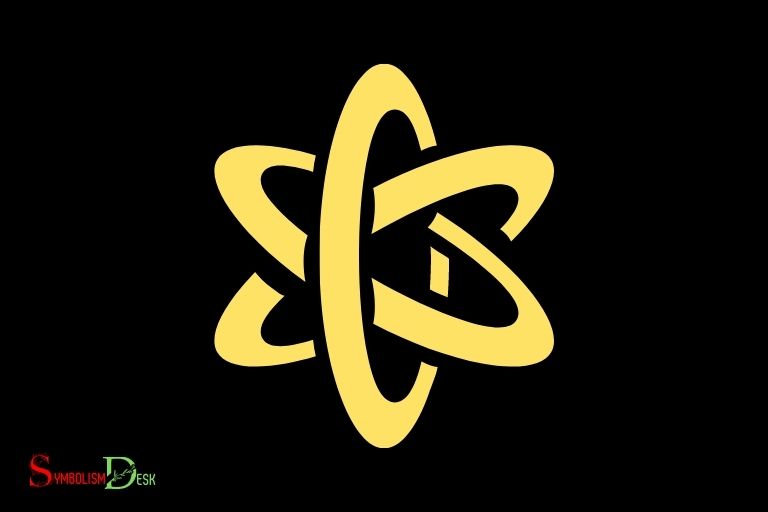What Does the Atheist Symbol Mean? Religious Faith!
The atheist symbol represents the absence of belief in deities or the rejection of religious faith, often depicted by the letter ‘A’ combined with the atomic whirl.
The atheist symbol, which is commonly recognized as the “A” symbol, is an adaptation of the atomic whirl.
This whirl, which represents an atom with its electrons circling the nucleus, symbolizes the importance of science, rational thought, and the natural world.
By incorporating the letter “A” into the symbol, it conveys atheism – the belief that no gods or supernatural beings exist.
This emblem is often used by secular organizations and individuals to show their rejection of religious beliefs and their support for secularism, free thought, and evidence-based reasoning.
The atheist symbol serves as a powerful and recognizable emblem for those who identify as non-believers or secularists.
It not only signifies the absence of religious faith but also highlights the importance of science and rational thought as alternative ways to understand the world.
By embracing this symbol, atheists and secularists demonstrate their commitment to evidence-based reasoning and the exploration of the natural world, free from religious dogma or supernatural explanations.
Interpretation and Significance of the Atheist Symbol
| Symbol | Meaning | Description |
|---|---|---|
| The Atheist “A” symbol or the “Scarlet A” | Represents atheism | The letter “A” in a circle represents atheism, derived from the English word “atheist.” The symbol is often used as an emblem by those who identify as atheists or promoters of atheism. |
| The Invisible Pink Unicorn (IPU) | Parody of religious symbols | The IPU is a satirical deity used to criticize religious beliefs. The concept is that the IPU is both invisible and pink so it cannot be detected, similar to the idea of an undetectable god. |
| The Flying Spaghetti Monster (FSM) | Parody of religious deities | The FSM is a satirical deity often used as a symbol for atheism. It was created to criticize the teaching of intelligent design and is often used humorously to comment on religious dogma. |
| The Darwin Fish | Supporting evolution | The Darwin Fish is a symbol of support for evolutionary theory, often used by atheists to counter religious criticisms of evolution. The fish is often depicted with legs and the word “Darwin” written on its side. |
| The Happy Humanist or Happy Human | Represents humanism | The Happy Human symbol, also known as Happy Humanist, is used by secular humanist and atheist organizations. It features a simple stick figure with arms and legs outstretched, symbolizing the happiness and freedom that can be found in a human-centered worldview. |
Key Takeaway

Five Facts About: The Atheist Symbol
What Does The Atheist Symbol Mean?
The atheist symbol has become well-known over the years among those who don’t believe in a god. It has a distinctive design that sparks curiosity among those who encounter it.
Definition Of The Atheist Symbol
The atheist symbol is a representation of atheism, which is the absence of belief in any divine being or supernatural entity.
The symbol has been designed in such a way that it expresses the ideas and beliefs of atheists in a simple, yet powerful form.
The Origin And Evolution Of The Symbol
The atheist symbol was first introduced in 2007 as part of a contest by the american humanist association.
The winning design was created by diane reed, an atheist artist. The symbol consists of a stylized atom with an ‘a’ in the middle.
The negative space between the ‘a’ and the atom represents the absence of belief in a god.
Over the years, variations of the symbol have been created, including an all-black or all-white version, and an infinity loop replacing the atom.
These adaptations reflect the diversity of opinions and personal expression within the atheist community.
Its Use In Various Contexts
The atheist symbol has been widely used in various contexts, from bumper stickers to jewelry, and even tattoo art.
Atheists use the symbol as a way to identify themselves, to show solidarity with others who share their beliefs, and to promote the idea that non-believers can be good people too.
The symbol has also been used as a symbol of protest against religious institutions, especially in countries where non-believers experience discrimination. The use of the symbol in this context is controversial and can lead to tensions with religious groups.
The atheist symbol is a meaningful representation of atheism that conveys the absence of belief in a god in a simple, yet powerful way. The symbol, often depicted as a letter A with a circle around it, represents the idea that there is no need for a deity in guiding one’s life and moral compass. It promotes the idea that individuals can navigate the complexities of the world without relying on a higher power for guidance. It embraces the concept of understanding hakuna matata, or living without worries, as a central tenet of atheism.
Its origin, evolution, and use in various contexts demonstrate how symbols can foster a sense of community and promote a shared worldview among those who share similar beliefs.
Understanding The Symbolism
The atheist symbol is a commonly known emblem that represents atheism. It is a composition of several elements that relate to the philosophy and beliefs that atheists hold.
If you are looking to learn about the different elements that make up the symbol and their meaning, you are in the right place.
In this section, we will be analyzing each element that makes up the atheist symbol and interpreting their meaning.
Analysis Of The Elements That Make Up The Symbol
The atheist symbol is made up of three distinct elements that combine to form the entire emblem:
- Circle
- Atom
- Absence of the cross or other religious symbols
Interpretation Of The Meaning Behind Each Element
The Circle
The circle is one of the elements that make up the atheist symbol. It represents inclusivity, wholeness, and completeness.
Atheists believe that the universe is a self-contained system and that everything in it is interconnected.
By using a circle, the atheist symbol suggests that everything is whole and part of a unity that is larger than any one individual.
The Atom
The second element that makes up the atheist symbol is the atom. The atom represents science, reason, and logic.
Atheists believe that science is the most reliable method for understanding the natural world.
Therefore, the inclusion of an atom in the atheist symbol reinforces the importance of scientific inquiry and the use of rationality and logical thinking in understanding the world around us.
The Absence Of The Cross Or Other Religious Symbols
The absence of the cross or any other religious symbol represents a lack of belief in a deity. Atheists do not believe in the existence of a god or gods.
Therefore, the absence of any religious symbols in the atheist emblem emphasizes this rejection of religious dogma.
The Colors Used
The colors used in the atheist symbol are black and white. Black represents the absence of color, while white represents the presence of all colors.
Together, they represent the ultimate balance between the positive and negative forces in the universe.
The color scheme also reinforces the idea of inclusivity, as black and white are colors that everyone can relate to regardless of culture or ethnicity.
The atheist symbol is a representation of the philosophy and beliefs held by atheists.
By combining the circle, the atom, and the absence of religious symbols, the atheist symbol emphasizes the importance of inclusivity, rationality, and science.
Criticisms And Controversies
The atheist symbol is a recognizable sign often used by individuals who reject the belief in the existence of a deity.
The symbol, commonly known as the atomic whirl or atom logo, consists of three main components, namely the letter “a,” a stylized atom, and an orbiting electron.
Although the atheist symbol was created to promote unity amongst non-believers, it has faced a fair share of criticisms and controversies.
Discussion Of Criticisms Against The Atheist Symbol
Despite its popularity and intended purpose, the use of the atheist symbol has been criticized on several fronts.
Here are some of the common criticisms levelled against the symbol:
- The symbol is seen as aggressive and divisive, rather than inclusive. Some people feel that the use of the symbol is a call to arms for atheists to rally against religious groups, rather than a means of fostering dialogue and understanding.
- The symbol is also perceived as insignifcant or of lesser value as compared to religious symbols. As a result, some people have argued that creating an atheist symbol is unnecessary since atheism, unlike religion, does not require symbols or icons.
- Some critics also argue that the symbol is impinging on the right to freedom of religious expression. They assert that the symbol, like any other religious symbol, should not be allowed in public or governmental settings.
Analysis Of Its Controversial Nature And Why It Is Often Misunderstood
The atheist symbol has been labeled as controversial mainly because of its perceived negative connotations.
Here are some reasons why:
- Misinformation and misconceptions: Many individuals who criticize the use of the atheist symbol do so out of ignorance or a lack of understanding about the symbol’s purpose and origin. They perceive the symbol as a direct attack on their religious beliefs, rather than a means to express non-belief in a deity.
- Fear of exclusion: Some people worry that the use of an atheist symbol will lead to the alienation and discrimination of religious individuals. Since atheism is not an organized religion, creating a symbol for it could further widen the gap between believers and non-believers, leading to more clashes.
- Societal stigmatization: In society, atheism is often stigmatized, and atheists are viewed as being immoral or lacking in values. It is possible that this stigma extends to the symbol, causing negativity towards it.
Comparison With Other Symbols That May Be More Widely Recognized
There are several other symbols that are more widely recognized than the atheist symbol.
Here are some examples:
- The cross: The cross is the most well-known symbol of christianity, representing the death and resurrection of jesus christ.
- The star of david: This symbol is used by the jewish community and is meant to represent their faith in god.
- The crescent and the star: The muslim faith is commonly associated with this symbol.
- The om: This symbol, used by the hindu community, represents the sound of the universe.
Despite the popularity of these symbols, it is important to note that they can also be a source of controversy and criticism, similar to the atheist symbol.
While the atheist symbol is meant to foster unity and promote recognition for an underrepresented group, it faces significant criticism and controversy.
These criticisms often stem from ignorance, misconceptions, and stigma surrounding atheism, which can lead to the symbol being viewed negatively.
It is important to note that symbols, regardless of their meaning, can be a source of division and conflict, or of unity and understanding depending on our perception of them.
The Evolution Of Atheism And Its Symbols
Atheism is the rejection of the belief in god or gods. Throughout history, atheists have tried to create and popularize symbols that reflect their beliefs.
The atheist symbol is a product of centuries of evolution and change. The concept of atheism and its symbols have also evolved with the development of science, rationalism, and secularism.
Overview Of The Evolution Of Atheism And Its Symbols
• atheism has been in existence since ancient times. The first recorded instance of atheism dates back to ancient india.
• in the ancient world, atheists were often persecuted and forced to keep their beliefs hidden.
• the rise of rationalism in the seventeenth and eighteenth centuries saw a surge in the number of atheists.
• the 19th century saw the emergence of secularism as a political and social movement.
• in the 21st century, atheism has become more mainstream, and as a result, its symbols reflect this change.
Comparison Of The Various Symbols Used By Atheists Throughout History
• the first recorded symbol of atheism was the atom, which represented the concept of materialism and naturalism.
• in the late nineteenth century, the letter “a” was adopted by the atheist community in the us as a symbol.
• the red “a” inside a circle has become the most widely recognized symbol of atheism in the modern era.
• other symbols that have been used by atheists include images of the universe, darwin’s tree of life, and the inverted cross.
How The Atheist Symbol Reflects The Evolution Of Atheism As A Movement
• the evolution of the atheist symbol reflects the growing acceptance of atheism as a valid belief system.
• the popularity of the red “a” symbol is evidence of the growing visibility and acceptance of atheists in society.
• atheists have used symbols as a way to express themselves as a community, and as a way to challenge the dominance of religion in society.
• the evolution of atheist symbols indicates a shift towards a more positive and proactive approach to atheism.
The evolution of the atheist symbol is a reflection of the evolution of atheism as a movement. As society becomes more accepting of atheism, so too do the symbols used by atheists become more positive and visible.
The red “a” symbol has become the most widely recognized symbol of atheism, reflecting the growing visibility and acceptance of atheists in modern society.
Can the Life Symbol also be interpreted as a symbol of religious faith?
The Life Symbol, representing vitality and progress, may indeed be interpreted as a symbol of religious faith. Just as life’s symbol of growth embodies the transformation and development in nature, it can also be seen as a metaphor for spiritual evolution and enlightenment. The concept of life’s symbol of growth embraces the idea that faith is a dynamic force, continuously evolving and flourishing.
FAQ About What Does The Atheist Symbol Mean
What Is The Symbolism Behind The Atheist Symbol?
The atheist symbol represents the absence of a belief in a god or deity.
Who Created The Atheist Symbol?
The symbol was created in 2007 by diane reed, a graphic designer from new jersey.
Why Is The Letter “A” The Symbol For Atheists?
The letter “a” represents “atheist” and also stands for “agnostic” or “agnosticism”.
What Is The Significance Of The Scarlet ‘A’ On The Symbol?
The scarlet “a” is inspired by the scarlet letter worn by hester prynne in nathaniel hawthorne’s novel, which symbolized the public shaming of those who committed crimes.
Is The Atheist Symbol Recognized Worldwide?
Although the symbol isn’t widely recognized, it’s becoming more commonly used among the atheist community as a means of self-identification.
Conclusion
As we wrap up our discussion on the meaning of the atheist symbol, it’s clear that the emblem has come a long way since the creation of the atomic whirl in the late 20th century.
While its origins may be uncertain, today, the symbol is recognized by many as a representation of the atheist community’s belief in science, reason, and critical thinking.
Its simplicity and versatility make it a powerful tool for spreading awareness about atheism and promoting free thought.
However, it’s important to note that the symbol is not unanimously accepted as representing every atheist’s beliefs and worldview, and some may choose to identify as non-believers without the need for any particular symbol.
Regardless of personal opinions, the rise and popularity of the atheist symbol demonstrates the growing recognition and acceptance of atheism as a valid and legitimate worldview.






